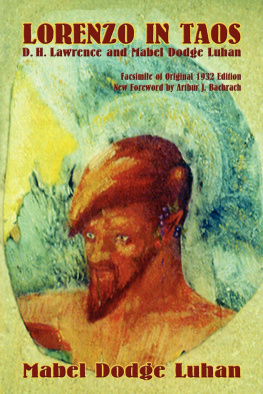
INTIMATE MEMORIES
INTIMATE MEMORIES
The Autobiography of Mabel Dodge Luhan
EDITED BY
Lois Palken Rudnick

ISBN for this digital edition: 978-0-8263-3249-3
1999 by Lois Palken Rudnick
All rights reserved. Published 1999
Preface 2014 by Lois Palken Rudnick
Paperbound ISBN-13: 978-0-8263-2106-0
Printed in the United States of America
20 19 18 17 16 15 14 2 3 4 5 6 7 8
The Library of Congress has
cataloged the printed edition as follows:
Luhan, Mabel Dodge, 18791962.
Intimate memories: the autobiography of Mabel Dodge Luhan/edited by Lois Palken Rudnick1st ed.
p. cm
ISBN 0-8263-1857-6ISBN 0-8263-2106-2 (pbk)
1. Luhan, Mabel Dodge, 18791962.
2. IntellectualsUnited States Biography.
3. Taos (N.M.) Biography.
I. Rudnick, Lois Palken, 1944 .
II. Title;
CT275.L838A3 1999
973.9092dc21
[B]
9924085
CIP
CONTENTS
PREFACE TO THE 2014 PRINTING
When the abridged version of Mabel Dodge Luhans autobiography, Intimate Memories, was first published in 1999, I had had very limited access to her unpublished memoirs, twenty volumes of which resided in the Beinecke Rare Book and Manuscript Library at Yale University, along with her other papers. They were put under restriction until the year 2000 by her son, John Evans, a few months before I began to research her life, in the early 1970s. After publishing my first two books on Luhan, I went back to the Beinecke to do further research for an essay I was writing.
While I was there I read Luhans last memoir, written in 1954 when she was seventy-five. There, Mabel discussed her multiple encounters with venereal disease, with her first lover and with three of her four husbands. While Emily Hahn, who published the first biography of Luhan, had discussed Mabels contracting syphilis from Tony Luhan, I had not known about these other cases, nor could I find out more until I was given access to her other unpublished memoirs. That happened in January 2000 and resulted in my writing about and editing Luhans unpublished memoirs in a book that was published in 2012 by the University of New Mexico Press: The Suppressed Memoirs of Mabel Dodge Luhan: Sex, Syphilis, and Psychoanalysis in the Making of American Culture.
Luhans unpublished memoirs, and ancillary materials, include letters to and from her therapists over the course of her life, and her first therapists case notes from her psychoanalysis in 1916. Reading and editing them did not radically alter my view of Luhan, but it definitely deepened my understanding of her fraught relationships with her parents, and of her damaged and damaging relationships with the men and women in her love life. I also gained greater compassion for her endless and sometimes seemingly absurd quests to find a waythrough psychiatry, theosophy, the occult, and the writing and revising of her memoirsof assuaging her agonizing cycles of manic depression.
In her published memoirs, as you will see, Luhan presents herself as a representative type of her times. For all that she suppressed and elided in her four volumes of published memoirs, they are a fascinating and illuminating window into late Victorian and early modern America. Even in the attenuated version of her life story that I present here (although Id argue that its the best of her memoirs that I have culled), you will, I believe, find this to be true.
When reading autobiography, we always have to remember that the self presented is the self constructed at a particular moment in time, and for particular purposes. Luhan constructed many selves over the course of her life, not all of whom agreed with one another. She undoubtedly lived up to the motto she took from Walt Whitmans poem, Song of Myself, that she had embossed on her stationary: Do I contradict myself? / Very well then I contradict myself. She could have added Whitmans next line: (I am large, I contain multitudes.)
The essay, titled The Male-Identified Woman and Other Anxieties: The Life of Mabel Dodge Luhan, was published in a book of essays written by nine biographers about why we chose our subjects and the impact they had on our professional and personal lives. The volume is titled The Challenge of Feminist Biography: Writing the Lives of Modern American Women, edited by Sara Alpern, et al. (University of Illinois Press, 1992).
INTRODUCTION
I started out to try & show the inward picture of a person of my own period; what heredity and environment had made of her. I did not believe, & do not believe, that she was inwardly so different from a lot of others. She was a 20th century type.
When she started to write her memoirs, she wrote incessantly, without stopping, day after day, lying on her sofa with a copybook and pencil. She poured herself untiringly into those books. The energy concentration was boundless, until all of a sudden the book was finished and Mabel resumed normal lifewhich was energetic enough, Heaven knows.
Mabel Dodge Luhan (18791962) began to write her autobiography in 1924, a process that took over a decade and resulted in a 1,600-page, four-volume opus that was published serially under the title Intimate Memories. Luhans memoirs are a fascinating eyewitness account of the United States entrance into modernity that take us from Victorian Buffalo, through fin-de-sicle Florence, into the radical heartland of preWorld War I Greenwich Village, and end with her discovery of the Indian Southwest as a place of personal and cultural renewal. Luhan wrote her memoirs from the point of view of a rebel who had spent much of her adult life constructing a series of utopian domains that were intended to overturn the whole ghastly social structure under which she felt the United States had been buried since the Victorian era.
Intimate Memories is an extraordinary achievement for a woman of Mabel Dodge Luhans time, especially for a woman with no claim to any particular professional accomplishment. Luhan made her mark primarily as a patron of social and cultural radicals and reformers who have achieved far greater renown than she in the annals of twentieth-century history. At the time she published her memoirs, however, Luhan was a well-established figure, variously described in the regional and national popular press as the first lady of Taos; one who foresaw in Taos an American Florence of American art; a hostess and angel to numerous writers, and the modern incarnation of the French dames who ran their salons for the struggling and successful writers of all nationalities; and one of the few women in the country who could be
The fact that Luhans publisher, Harcourt Brace & Company, allowed her the luxury of four volumes in which to tell the story of the first forty years of her life is testimony to her national prominence, particularly given their publication during the heart of the Great Depression. Yet both the sales figures and the reviews of her memoirs were (on the whole) disappointing. It is one of the ironies of Luhans life that the publication of Intimate Memories reinforced the worst impressions of some of the leading leftist critics of the 1930s, who read her autobiography as a parable of the social decline and economic fall of the United States. Malcolm Cowley summed up her life as the case history of an art patroness under capitalisma fable told round the fireside to edify and frighten little Russian children, while Granville Hicks recommended the book as an incomparable account of the destruction that can be wrought by money when it is in the hands of intelligence and determination.
Next page







